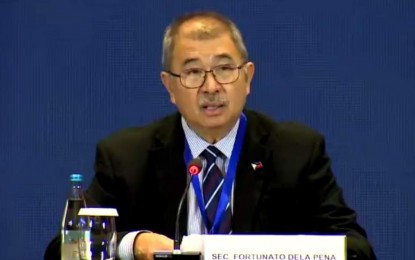
DOST Secretary Fortunato de la Peña (Photo grabbed from Phivolcs' Facebook page)
MANILA – Department of Science and Technology (DOST) Secretary Fortunato de la Peña on Thursday noted the significant contribution of science, technology, and innovation (STI) in harnessing disaster resilience.
"STI is at the core of disaster risk reduction -- from understanding the concept of risks, to building back better. The vigorous advancement of STI has allowed us to apply strategies and develop policies to mitigate risks and build resilience," he said at the Asia Pacific Science and Technology Conference for Disaster Risk Reduction held via Zoom.
Filipino resilience, he said, has been known as not just about mere survival, but the ability to adapt and transform.
"In disaster response, the data gathered by the DOST from the technologies we have developed is the backbone of our approach to responding to disaster impact. We ensure that with early warning, there’s early action," he said.
The DOST, he said, has accomplished several innovations that target to prevent and mitigate disasters, as well as to aid in rehabilitation efforts.
In terms of prevention and mitigation, the country has been using data from Filipino-made microsatellites and nanosatellites. The satellite data and sensors are beneficial in hazard mapping, and assessing the environmental condition and status on the ground.
A digital platform to know hazards and risks called GeoRisk Philippines has already been developed through a multi-agency initiative led by the Philippine Institute of Volcanology and Seismology (Phivolcs), funded by the DOST.
Through this platform, scientific data was made available to the public. De la Peña said the key features of this platform is the quick generation of hazard and risk assessments.
The DOST also enabled the weather bureau to boost its forecasting capability via the Understanding Lightning and Thunderstorm or ULAT research project. Lightning occurrences are being monitored to find out its relation to the weather forecast for the next hours or days. This enables the weather bureau to give additional information and warning about the strength, direction and other pertinent details related to a rain event.
De la Peña also mentioned the Filipino-made Universal Structural Health Evaluation and Recording System or USHER, which monitors the "health" of buildings and bridges to determine if they could withstand a strong earthquake. At least 30 researchers and professors from Mapua University in Manila worked on the USHER equipment through funding from the DOST.
The data or analysis from USHER can be accessed by building owners and structural engineers through cloud.
Also with regard to disaster preparedness, the DOST has developed a software called Rapid Earthquake Damage Assessment System or REDAS. "It simulates earthquake hazards such as ground shaking, liquefaction, landslides, and tsunami, and can compute earthquake impacts in terms of physical damage, casualties, and economic loss," the DOST chief said.
As for rehabilitation efforts, the Philippine Earth Data Resource and Observation or PEDRO Center monitors the rehabilitation of several infrastructure projects through its ground receiving stations equipped with earth observation satellite tracking antennas that receive, process, and distribute images and other space-borne data.
The DOST also ensures that disaster relief goods are nutritious by developing nutritious emergency food. Among these include ready-to-eat rice porridge and smoked fish rice meals, and BigMo (bigas/rice - mongo) curls.
"STI has shown that we can reduce or prevent the impact of disasters. The DOST commits to lead the trends in S&T, and make visionary planning for research and application, specifically in disaster risk reduction," he said. (PNA)
